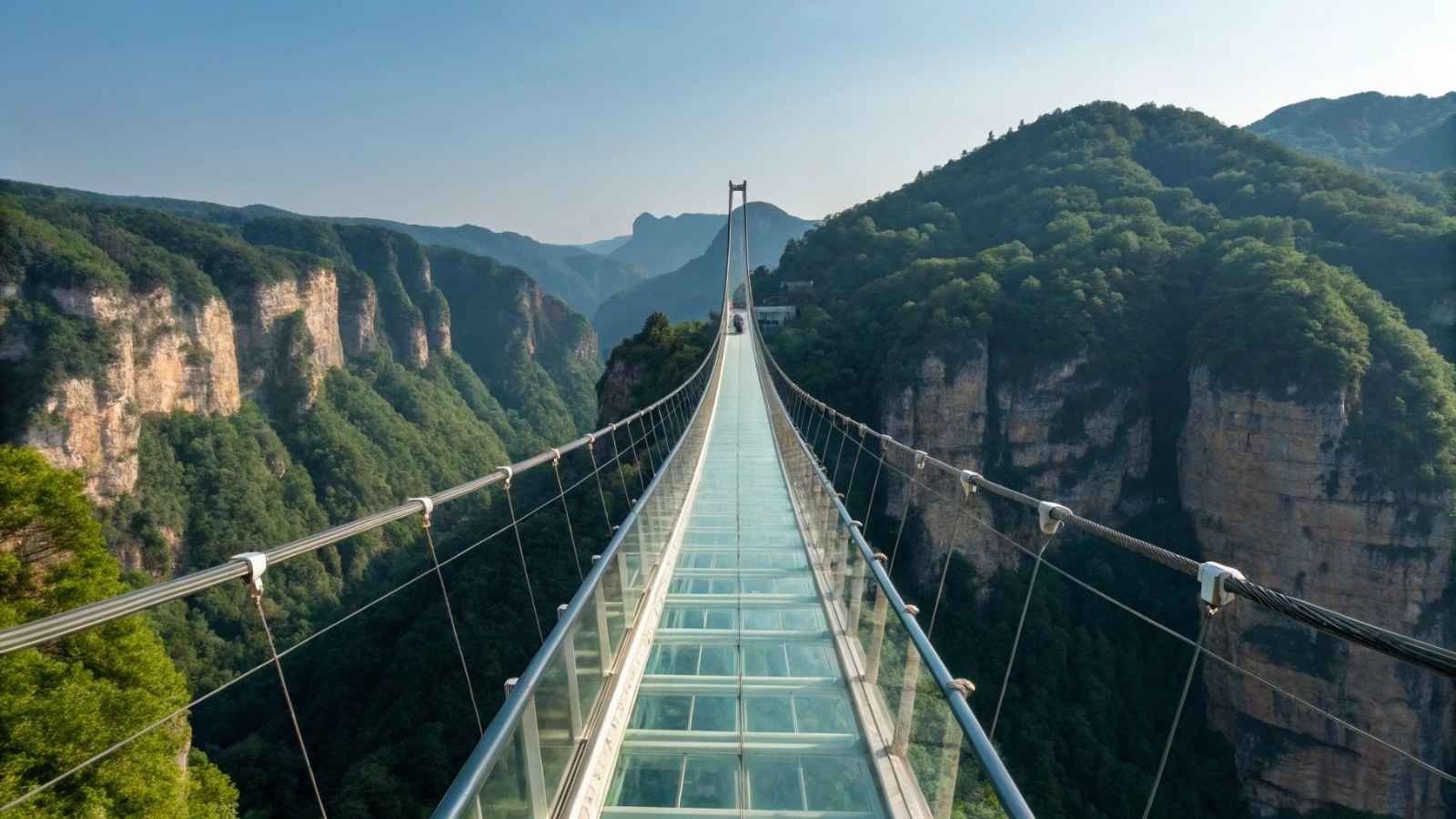
Your palms sweat. Your heart races. Every step feels like a dare against gravity itself. Some bridges aren’t just crossings—they’re gut-checks, engineering marvels that flirt with disaster just to connect two points on a map.
These aren’t your grandma’s footbridges. They’re narrow, swaying, crumbling, or see-through nightmares that’ll either leave you breathless or send you scrambling back to solid ground.
Why do we cross them? For the thrill? The views? Or just to prove we can? This isn’t just a list—it’s a challenge. If you’ve ever wondered how far fear can push you, keep reading. Your knees won’t thank you.
1. Zhangjiajie Glass Bridge (China)

Dubbed the “Bridge of Courage,” this engineering marvel stretches 430 meters (1,410 feet) across a dizzying 300-meter (984-foot) drop in Zhangjiajie Grand Canyon. What makes it truly terrifying? The entire walkway is made of transparent glass panels, giving you a stomach-churning view straight down into the abyss. If that’s not enough, the bridge is designed to wobble slightly in the wind—just to keep your adrenaline pumping!
I’ll be honest—I’m not usually afraid of heights, but watching people crawl across this thing on all fours (yes, that happens) made me question my bravery. The bridge also holds the record as the world’s longest and highest glass-bottomed bridge, and for good reason. If you’re looking for a thrill that’ll make your knees weak, this is it.
Best Time to Visit:
- April to October (Avoid winter—fog can obscure views, and the glass gets slippery.)
Key Facts: - Length: 430m (1,410 ft)
- Height: 300m (984 ft) above ground
- Fun Fact: Only 800 visitors are allowed per day for safety.
2. Eshima Ohashi Bridge (Japan)

This bridge looks like something out of a rollercoaster simulation—its insanely steep incline (6.1% gradient!) makes it appear almost vertical from certain angles. Connecting Matsue and Sakaiminato, this 1.7 km (1.1 mile) beast is so steep that drivers feel like they’re launching into the sky.
The first time I saw a photo of this bridge, I thought it was a perspective trick—but nope, it’s real. While it’s safer than it looks (thanks to modern engineering), the sheer visual shock of approaching it is enough to make your stomach flip. Locals joke that you need a “strong heart” to cross it, and after seeing trucks crawl up like ants on a wall, I believe them.
Best Time to Visit:
- Year-round (But avoid heavy rain—visibility drops fast.)
Key Facts: - Gradient: 6.1% (one of the steepest in the world)
- Length: 1.7 km (1.1 miles)
- Fun Fact: Nicknamed “The Rollercoaster Bridge.”
3. Capilano Suspension Bridge (Canada)
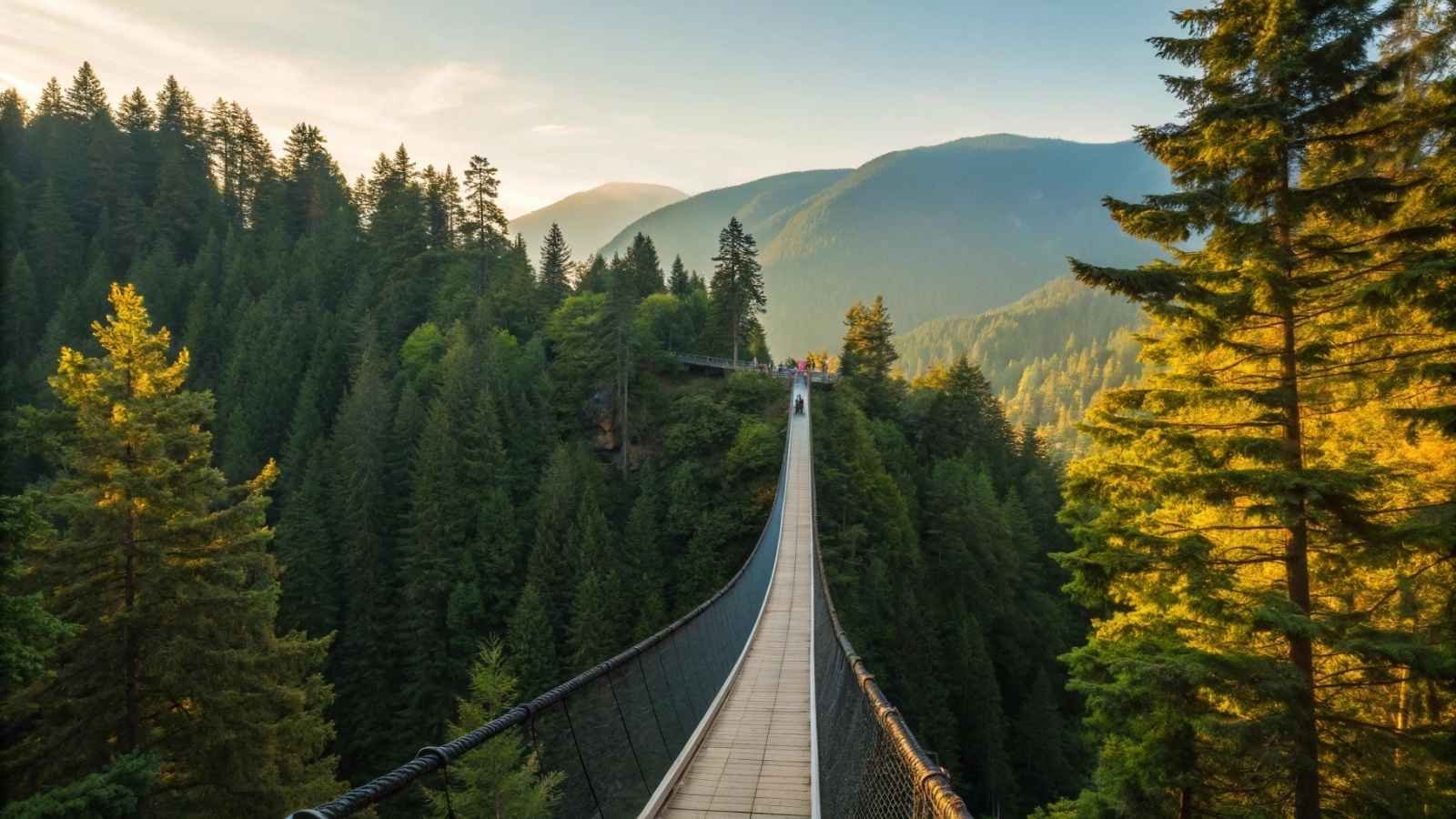
If swaying 70 meters (230 feet) above a roaring river in a rainforest sounds like your idea of fun (or terror), this Vancouver landmark delivers. Built in 1889, this 140-meter (460-foot) long bridge bounces with every step, and the dense forest below makes the drop look even more intimidating.
I visited in autumn, and let me tell you—the golden leaves and misty air made it feel like walking into a fantasy novel… until I looked down. The bridge also has a “Cliffwalk” extension—a narrow, cantilevered walkway clinging to the granite cliffs. Not for the faint-hearted!
Best Time to Visit:
- September to November (Fall foliage is stunning.)
Key Facts: - Height: 70m (230 ft)
- Age: Built in 1889 (still holding strong!)
- Fun Fact: Over 1.2 million visitors cross it yearly.
4. Trift Bridge (Switzerland)
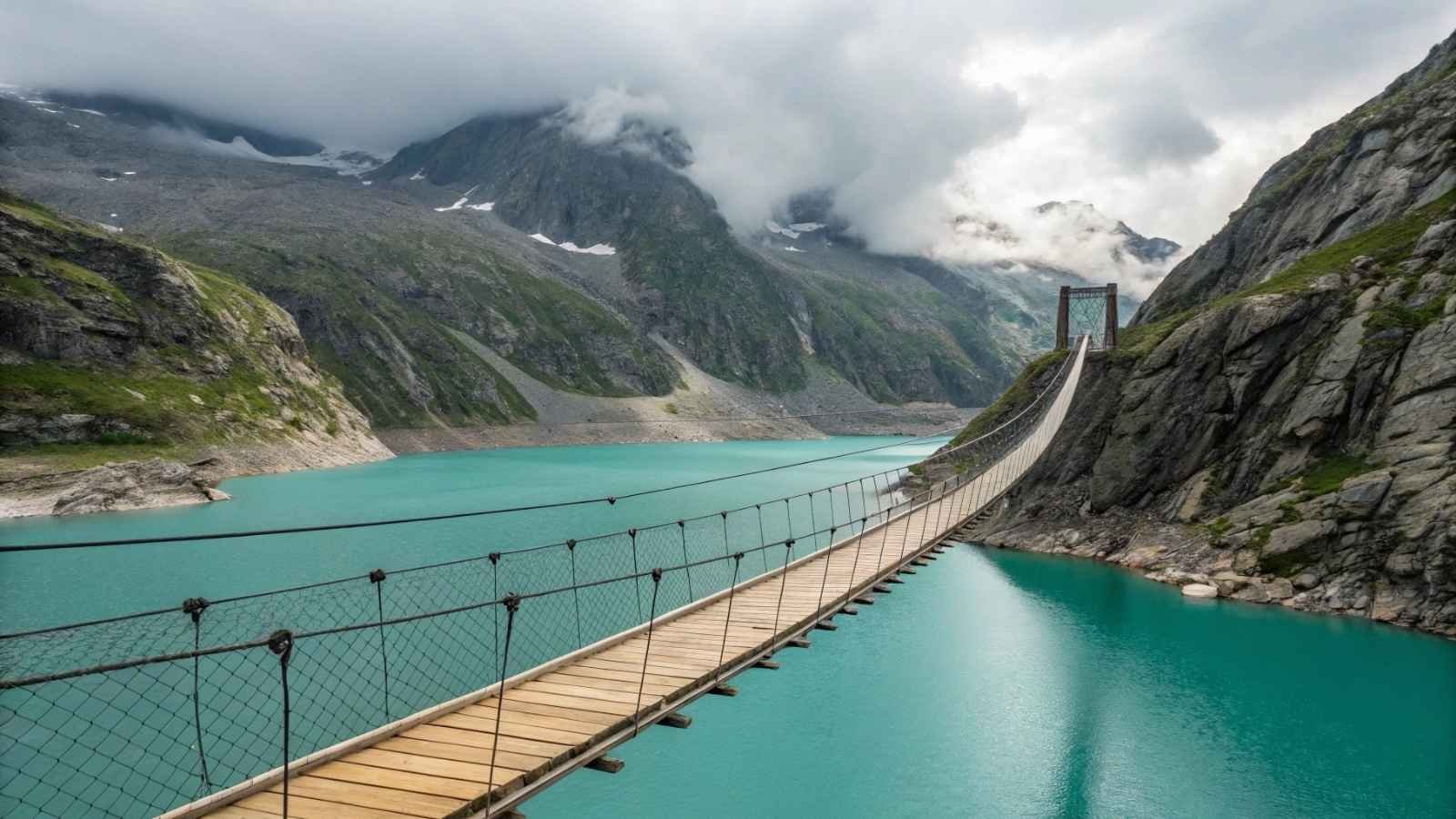
This suspension footbridge in the Swiss Alps is not for casual hikers. At 100 meters (328 feet) high and 170 meters (557 feet) long, it dangles over a glacial lake with nothing but thin cables keeping you from a very cold plunge. The wind here is no joke—it swings like a pendulum, and the metal grates let you see straight through.
When I crossed it, I made the mistake of looking down—big mistake. The combination of altitude, wind, and swaying motion made my legs feel like jelly. But the reward? Some of the most unreal alpine views on the planet.
Best Time to Visit:
- June to September (Winter access is dangerous.)
Key Facts: - Height: 100m (328 ft)
- Location: Near Gadmen, Switzerland
- Fun Fact: Originally built for hydropower workers.
5. Royal Gorge Bridge (USA)

Perched 291 meters (955 feet) above the Arkansas River, this Colorado bridge was the world’s highest from 1929 until 2001. Walking across its wooden planks (yes, wooden!) with gaps between them is a test of nerves. Oh, and if that’s not enough? There’s a zipline and gondola for extra thrills.
I visited in summer, and the sheer canyon depth was mind-blowing. The bridge creaks underfoot, and the wind howls through the gorge, making it feel like an old Western movie set. If you’re brave enough, lean over the edge (with the safety rails, of course) and peer into the river below.
Best Time to Visit:
- May to October (Winter winds are brutal.)
Key Facts: - Height: 291m (955 ft)
- Built: 1929 (survived multiple wildfires!)
- Fun Fact: Has a “Skycoaster” swing that drops you over the edge.
6. Kuandinsky Bridge (Russia)
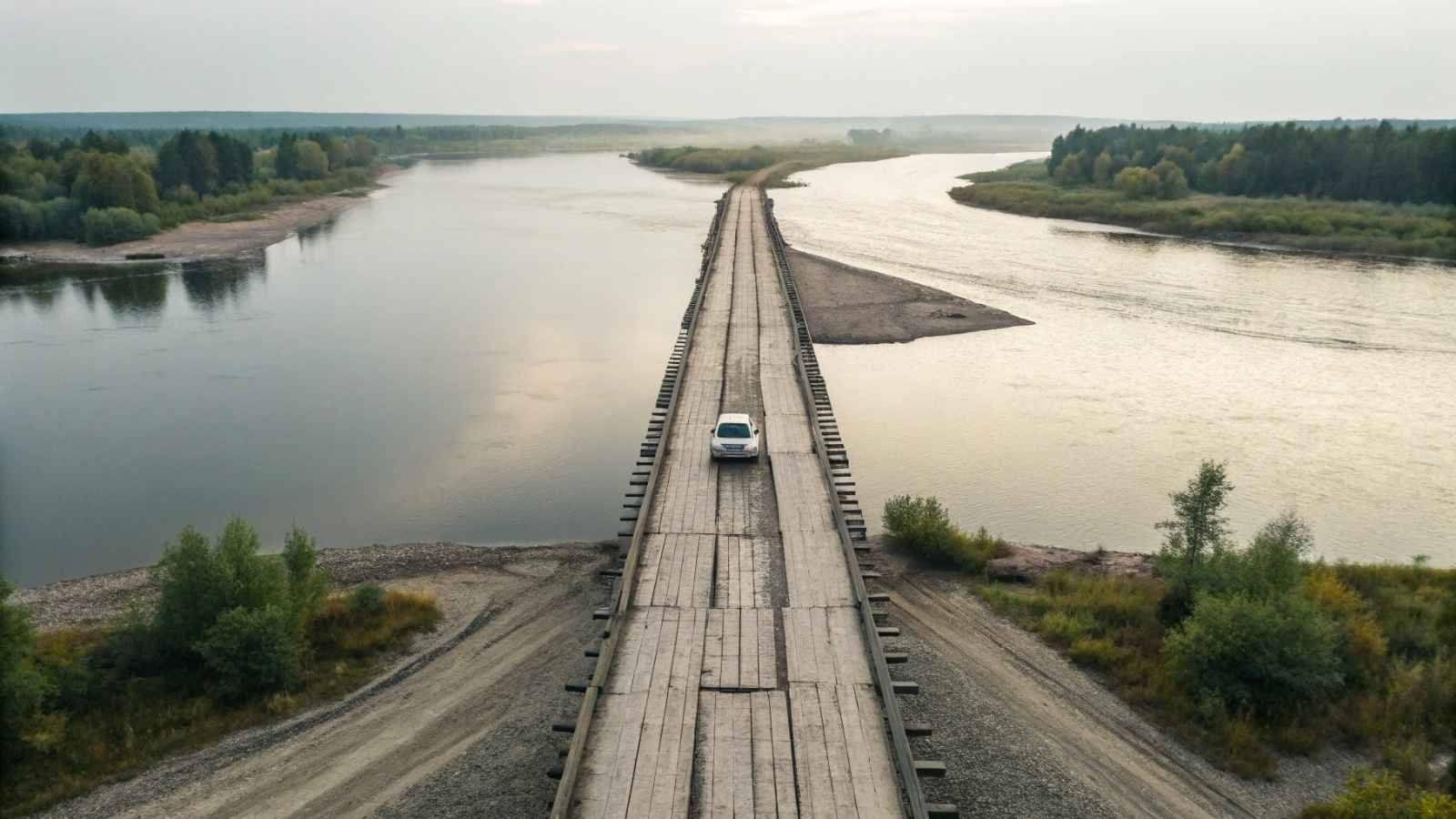
Picture this: a half-finished railway bridge in Siberia, with no guardrails, missing planks, and a sheer 35-meter (115-foot) drop into icy waters below. Oh, and it’s still occasionally used by trains. That’s the Kuandinsky Bridge—a true test of survival instincts.
When I first saw photos of this monstrosity, I thought it was abandoned. Nope. Locals (and some very brave drivers) navigate this death trap in trucks and motorcycles. The wooden beams creak, the gaps are wide enough to fall through, and one wrong move means a bone-chilling plunge into the Vitim River. If you’re looking for a bridge that feels like a post-apocalyptic challenge, this is it.
Best Time to Visit:
- July to August (Winter? not. Ice + no rails = nightmare fuel.)
Key Facts: - Height: 35m (115 ft)
- Length: 570m (1,870 ft)
- Fun Fact: Nicknamed “The Bridge of Death” by locals.
7. Hussaini Hanging Bridge (Pakistan)
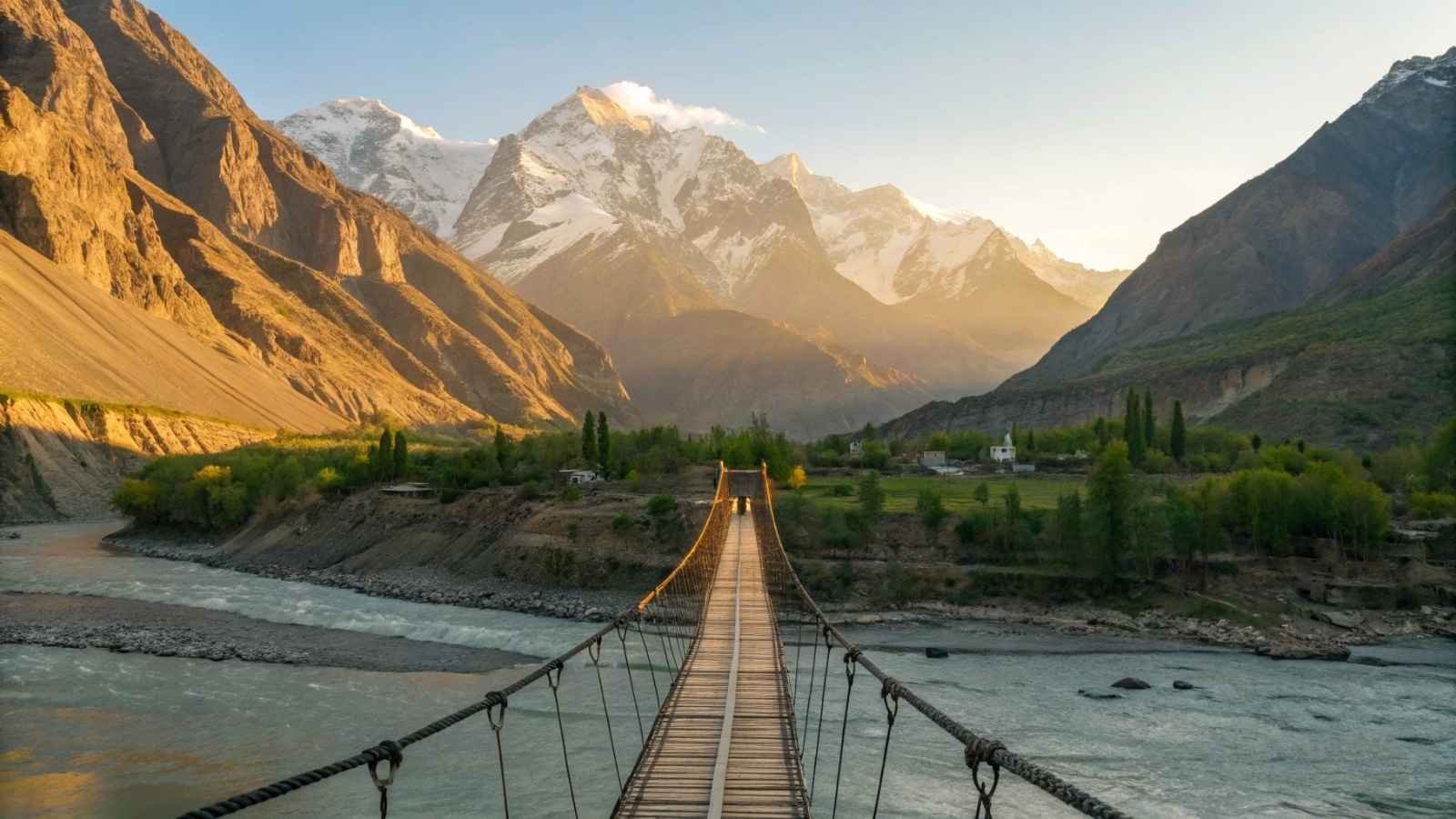
This rope-and-plank nightmare in northern Pakistan is what happens when “good enough” engineering meets “I really need to cross this” desperation. The bridge dangles over the rushing Hunza River, with missing planks, frayed ropes, and a sway that’ll make your soul leave your body.
I’ve seen videos of hikers balancing like tightrope walkers, and let me tell you no, thank you. The wind whips through the gorge, the ropes groan, and the gaps between planks are big enough to lose a leg in. Yet, villagers use it daily. If you want a taste of raw, unfiltered adventure, this is your bridge. Just… maybe don’t look down.
Best Time to Visit:
- May to September (Winter brings snow and even more danger.)
Key Facts: - Length: 200m (656 ft)
- Material: Wooden planks + rope (yes, just rope)
- Fun Fact: There’s a newer, safer bridge nearby… but thrill-seekers ignore it.
8. Carrick-a-Rede Rope Bridge (Northern Ireland)

This 20-meter (66-foot) high rope bridge was originally built by salmon fishermen 350 years ago, and it feels like it hasn’t been updated since. Suspended over jagged cliffs and crashing waves, the bridge bounces with every step, and the Atlantic wind tries its best to knock you off balance.
I crossed it on a cloudy day, and the combination of slippery planks and gusts of wind made me grip the ropes like my life depended on it (because, well, it kinda did). The views of the Irish coastline are stunning, but your focus will be 100% on not becoming seagull food.
Best Time to Visit:
- April to September (Winter closures due to high winds.)
Key Facts: - Height: 20m (66 ft)
- History: Built by 18th-century fishermen
- Fun Fact: Only 8 people are allowed on at a time.
9. Marienbrucke Bridge (Germany)
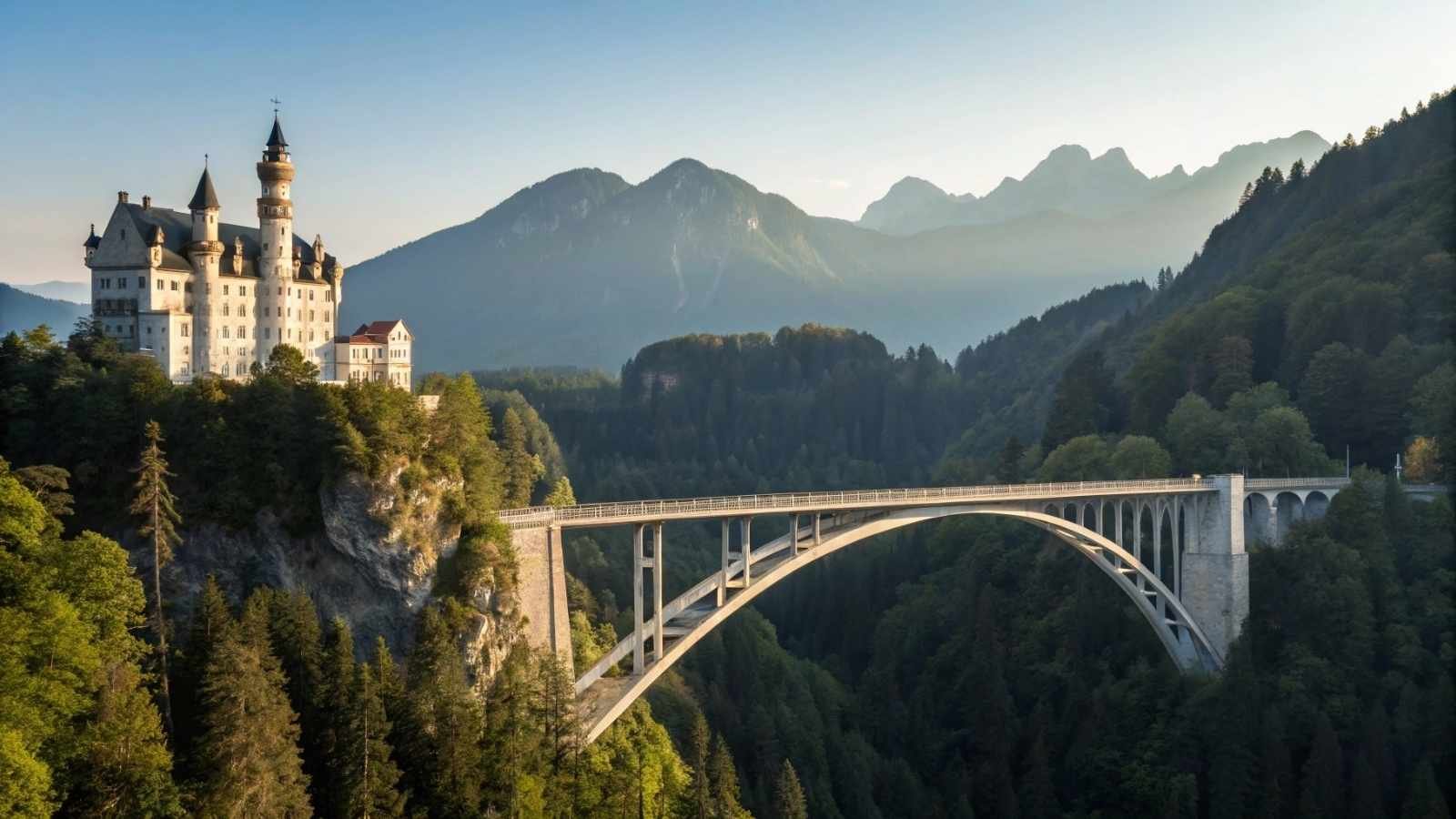
This narrow, wooden footbridge offers a postcard-perfect view of Neuschwanstein Castle… and also a heart-stopping drop into the Pöllat Gorge below. The bridge shakes when crowded, and the railings feel suspiciously low.
I visited in summer, and the swarms of tourists made the bridge feel even more precarious. Leaning over for that perfect castle selfie? Yeah, good luck—your knees will be shaking too much to hold the camera steady.
Best Time to Visit:
- June to October (Winter access is limited and icy.)
Key Facts: - Location: Near Füssen, Bavaria
- Best For: Castle views (if you dare take your eyes off your feet)
- Fun Fact: Named after Queen Marie of Bavaria.
10. Langkawi Sky Bridge (Malaysia)
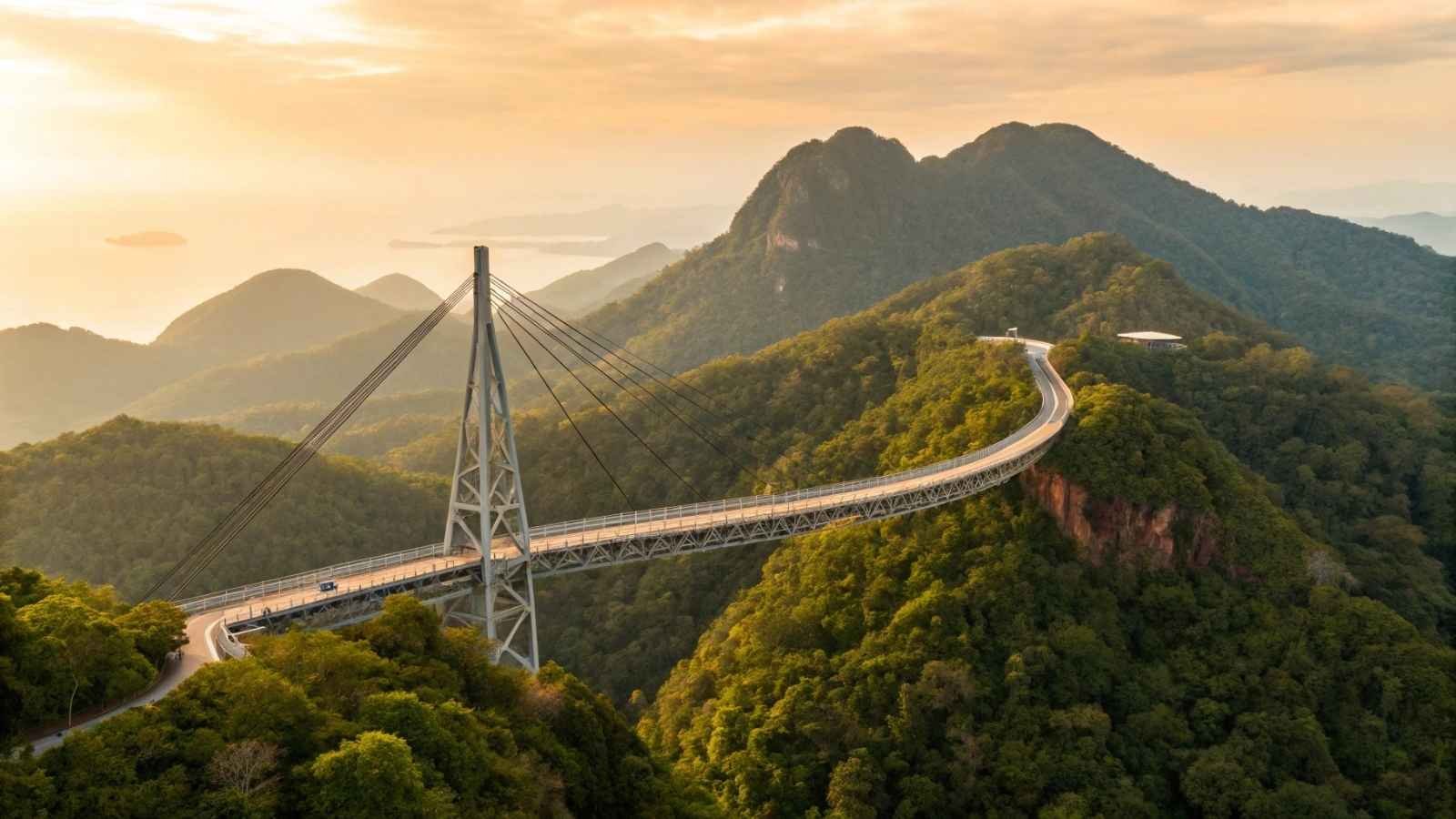
This curved pedestrian bridge sits 700 meters (2,300 ft) above sea level, held up by a single pylon on Mount Mat Cincang. The glass-floor sections give you a stomach-dropping view of the rainforest canopy below, and the whole thing sways in the wind.
When I visited, the fog rolled in mid-crossing, making it feel like I was walking into the void. The bridge’s unique design is an engineering marvel, but when you’re up there, all you’ll be thinking is: “Please don’t collapse.”
Best Time to Visit:
- December to March (Avoid monsoon season.)
Key Facts: - Height: 700m (2,300 ft)
- Structure: Single-support pylon
- Fun Fact: Closed for years for safety upgrades (yikes).
11. Puente de Ojuela (Mexico) – The Ghost Town’s Haunting Passage
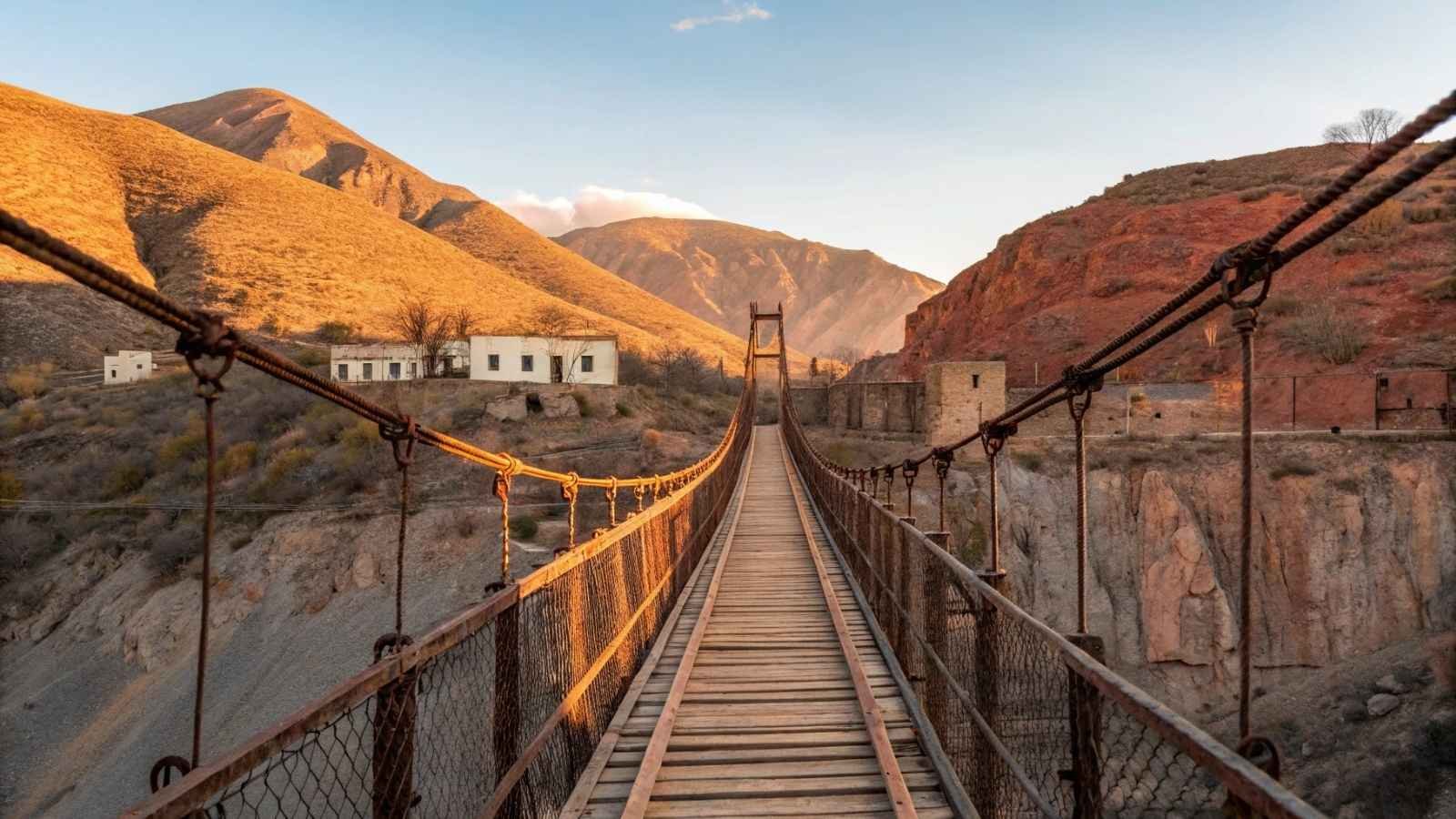
Imagine a wooden skeleton of a bridge, creaking in the wind, leading to an abandoned mining town in the Mexican desert. That’s Puente de Ojuela—a 318-meter (1,043-foot) relic from the 1800s, dangling over a canyon with rotting planks and rusted cables.
I’ll admit, abandoned places give me chills, but this one takes it to another level. The bridge was once the longest suspension bridge in the Americas, but now? It feels like something out of a horror movie. Every step sends vibrations through the fragile structure, and the gaps between planks are wide enough to see straight through to the rocky abyss below. Locals say it’s safe… but would you trust a 150-year-old bridge?
Best Time to Visit:
- October to April (Avoid summer—scorching heat makes the metal painfully hot.)
Key Facts: - Length: 318m (1,043 ft)
- Status: Mostly abandoned, but still open to daring visitors
- Fun Fact: The nearby ghost town, Ojuela, is said to be haunted.
12. Q’eswachaka Rope Bridge (Peru) – The Last Inca Rope Bridge

This isn’t just a bridge—it’s a living tradition. Every year, Peruvian villagers hand-weave a new bridge from grass ropes, just like their Inca ancestors did. The result? A 36-meter (118-foot) swaying death trap over the Apurímac River, with gaps wide enough to lose a sandal (or worse).
Crossing Q’eswachaka feels like stepping back in time—no bolts, no steel, just braided grass and prayers. The bridge bounces with every step, and the river below rushes violently. When I visited, the locals laughed as tourists white-knuckled the ropes. “Don’t worry,” they said. “It’s stronger than it looks.” (Famous last words?)
Best Time to Visit:
- June (During the annual bridge-renewal festival—best time to see it rebuilt!)
Key Facts: - Material: Totora grass ropes
- Rebuilt: Every single year
- Fun Fact: One of the last remaining Inca-style rope bridges.
13. Seven Mile Bridge (USA) – The Never-Ending Ocean Sprint
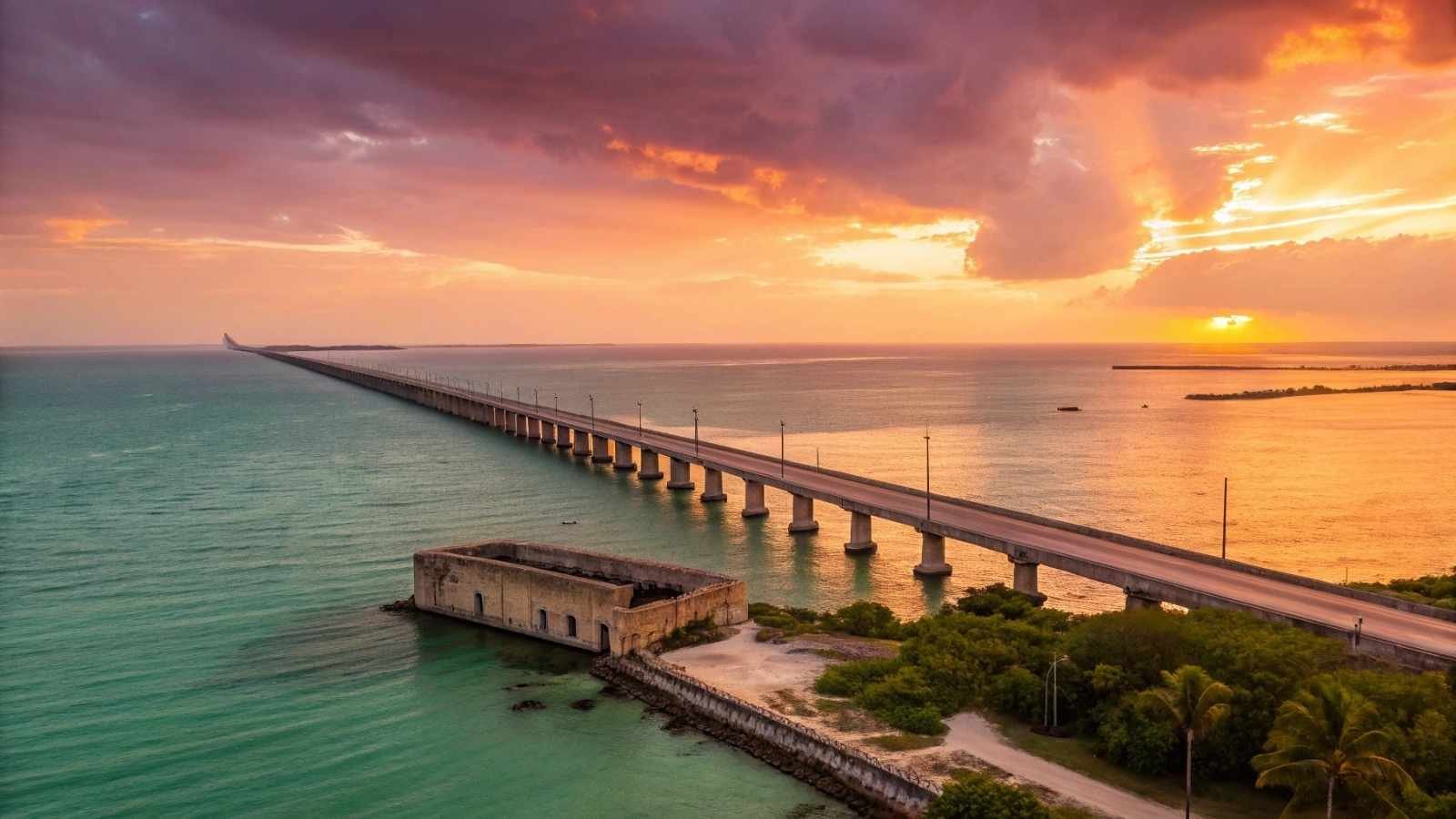
This one’s less about height and more about psychological terror. Stretching 11 km (7 miles) over the shark-infested waters of the Florida Keys, this bridge feels like it never ends. The guardrails are low, the road is narrow, and hurricanes occasionally rip chunks out of it.
Driving across at sunset? Gorgeous. Driving across during a storm? Terrifying. The horizon disappears, the waves crash against the pillars, and you’ll white-knuckle the wheel like it’s a life raft. And if your car breaks down? Well… Hope you like swimming with barracudas.
Best Time to Visit:
- December to April (Avoid hurricane season—June to November.)
Key Facts: - Length: 11 km (7 miles)
- Danger Level: High in storms, moderate otherwise
- Fun Fact: The old, crumbling section is now a fishing pier.






